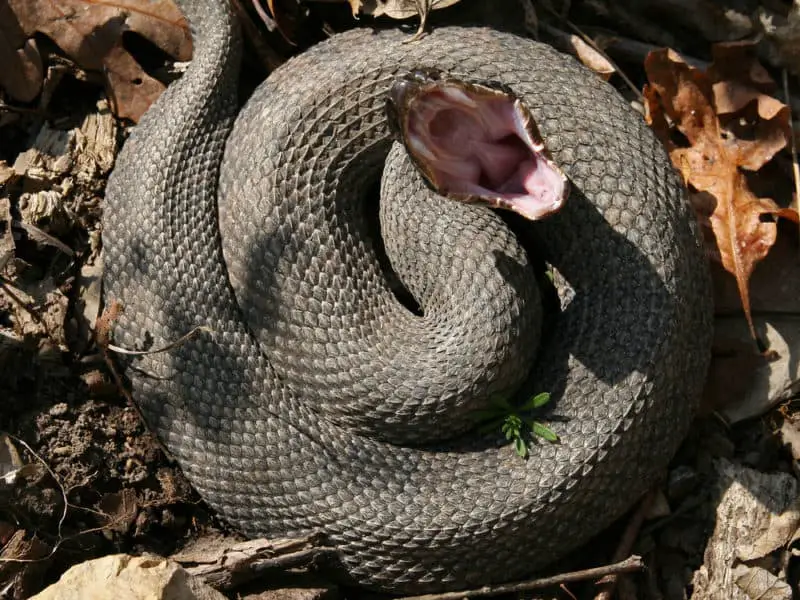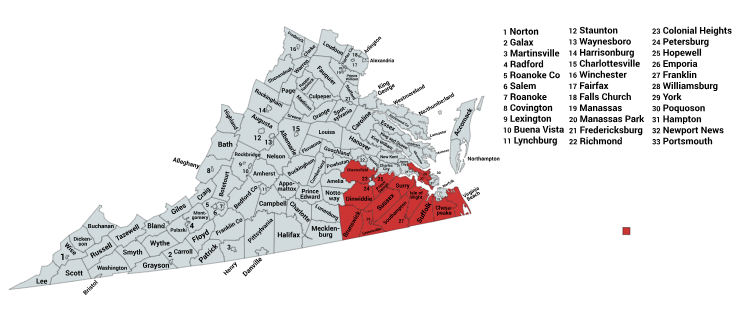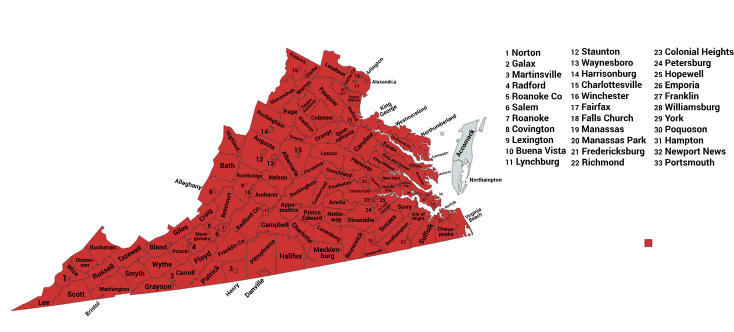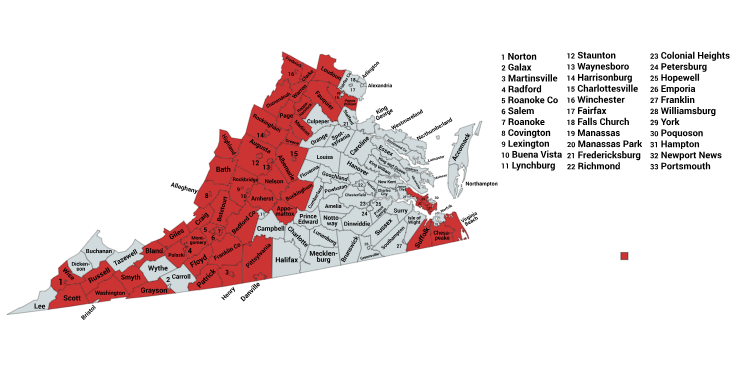There are 3 venomous snake species in Virginia. They are the following:
- Northern Cottonmouth (Agkistrodon piscivorus)
- Eastern Copperhead (Agkistrodon contortrix)
- Timber Rattlesnake (Crotalus horridus)
Each of these snakes poses potential risks. In fact, an average of 217 people are bitten by Virginia’s venomous snakes each year.
If you enjoy spending time outdoors, it’s crucial to know how to identify these snakes, understand their behavior, and recognize their habitats. It will make you safer. In this article, we’ll provide detailed information on each species, including tips for identifying them and navigating their presence in Virginia’s natural spaces.
Pit Vipers: The Venomous Masters of Infrared Detection
Rattlesnakes, Copperheads, and Cottonmouths are among the most well-known members of the venomous Crotalinae subfamily, also referred to as pit vipers. These snakes are equipped with unique adaptations that make them exceptional hunters.
What Makes Pit Vipers Unique?
- Infrared-Sensing Pits:
A defining feature of pit vipers is the deep facial pit between their nostril and the eye on each side of their head. These specialized infrared-detecting organs allow pit vipers to sense heat emitted by prey. This adaptation enables them to:- Detect body heat from up to 1 meter away.
- Strike prey with pinpoint accuracy, even in complete darkness.
- Triangular Heads and Vertical Pupils:
- Head Shape: Pit vipers are recognized by their distinct triangular-shaped heads, which house their venom glands.
- Eyes: They have vertical elliptical-shaped pupils.
- Venomous Fangs:
Pit vipers have hollow fangs connected to venom glands. These fangs fold back against the roof of their mouth when not in use.
Ecological Importance
Pit vipers play a crucial role in maintaining ecosystem balance by controlling rodent populations. Despite their fearsome reputation, these snakes are vital to the health of many habitats.

Northern Cottonmouth (Agkistrodon piscivorus)
Common names for the Northern Cottonmouth are water moccasins and stump-tailed moccasins.
What Do Northern Cottonmouths Look Like?
| Coloration | *Adults: Dark brown to black body with minimal markings. *Inside of the mouth: White, giving them the name “cottonmouth.” *Juveniles: More defined patterns, resembling a copperhead with darker bands that widen toward the belly and narrow along the back. *Inside is pale pink to white, visible during their defensive open-mouthed pose (origin of the name “cottonmouth”). |
| Body Shape | *Stout, muscular snakes. |
| Size | *These snakes grow up to 3 feet (0.91 m) in length. |
| Behaviors | *Cottonmouths arc their heads upward and display an open-mouthed pose when agitated. This exposes the white interior of their mouth. This is a warning to back off or suffer the consequences. *Interestingly, they can hold their breath underwater for up to an hour while hunting for prey. |
| Distinctive Features | *Pupils are cat-like and elliptical, appearing as narrow slits during the day. At night, pupils appear round. |
| Conservation Status | * Not considered a Species of Special Concern at this time. |
Where Do Northern Cottonmouths Live in Virginia?

These snakes are found in southeastern Virginia. They usually hang out near swampy areas, drainage ditches, slow-moving rivers, and lakes.
What Do Northern Cottonmouths Eat?
These snakes prey on fish, freshwater crustaceans, amphibians, small mammals, and other reptiles. Cottonmouths sometimes congregate around drying wetland pools to feed on any trapped fish.
How Dangerous Are Northern Cottonmouths?
Northern Cottonmouth venom is cytotoxic. This means it destroys body tissue. Northern Cottonmouth bites sometimes lead to the amputation of limbs. On rare occasions, Northern Cottonmouth envenomation leads to death.

Eastern Copperhead (Agkistrodon contortrix)
The Eastern Copperhead snake is a pit viper native to the eastern and mid-western United States.
| Coloration | *Reddish-tan to grayish-tan bodies. *Overlaid with dark brown, hourglass-shaped markings. *Heads are dark coppery brown, giving them the name “Copperhead.” |
| Body Shape | *Stout and heavy-bodied snakes. *As with all pitvipers, their heads are triangular and appear oversized in relation to their necks. |
| Size | *Adults range from 20 to 37 inches (50 to 95 cm) in length. |
| Conservation Status: | Most common venomous snake in Virginia. |
Taxonomy of Virginia’s Eastern Copperhead Snakes
Copperhead snakes are found throughout Virginia. Today they are recognized as a single species: the Eastern Copperhead (Agkistrodon contortrix).
In the past, these snakes were classified into different subspecies, including the Northern Copperhead, Southern Copperhead, and Osage Copperhead. However, recent DNA studies revealed minimal genetic differences between them. As a result, these subspecies were combined into a single taxonomic group under the Eastern Copperhead name.
Where Do Eastern Copperhead Snakes Live In Virginia?

You will find the Eastern Copperhead throughout the state of Virginia, except the barrier islands. They are found in river bottoms where the leaf and plant debris provide cover for them to hide. They are also, at times, located in wooded suburbs.
Eastern Copperhead Behavior
Copperheads have excellent camouflage coloration. It helps them blend in with leaf litter and other ground debris. Furthermore, they use camouflage as their number one defense mechanism. In other words, these snakes choose to lie perfectly still rather than flee most of the time.
For defensive behavior, they occasionally mimic the tail vibration of a rattlesnake. But, in most cases, they choose to lie perfectly still.
Most copperhead bites on humans occur when the person steps on or near the snake.
What Do Eastern Copperheads Eat?
Copperheads prey on a variety of species. Their menu includes small rodents, amphibians, small birds, snakes, lizards, and insects.
How Dangerous are Copperheads?
Venomous copperhead snakes can bite and inject venom when they are newly born. Like most pit vipers, they have hemotoxic venom.
Most copperhead bites are not life-threatening. On the other hand, any bite from this snake is a medical emergency and should be treated as such. If a copperhead bite victim gets medical help fast, they have a better chance of a positive outcome.
Copperhead bites can cause intense pain, shock, and swelling. Their bites also have the potential to cause blood in urine, tissue damage, and kidney failure.
An interesting study has found that Copperhead venom contains a protein called contortrostatin. Contortrostatin has been found to stop the growth of cancer cells in mice.
Scorpions in Virginia – Krebs Creek
Rattlesnakes in Virginia
What Virginia’s timber rattlesnakes have in common with most other rattlesnake species is their rattle.
- Most rattlesnakes have a rattle at their tail’s end, comprised of hollow, loosely interlocked keratinous scales.
- Normally, a rattlesnake adds a new segment to its rattle each time it sheds its skin.
- An agitated rattlesnake rapidly vibrates its tail, causing the segments of its rattle to vibrate together, creating a buzzing or rattling sound.
- Not all of Virginia’s rattlesnakes rattle before they strike. Sometimes, they lose their rattles due to injury, and sometimes, they choose not to rattle.

Timber Rattlesnake (Crotalus horridus)
Timber Rattler and Canebrake Rattlesnake are both common names for the Timber Rattlesnake. Generally, in higher-elevation habitats, they are called Timber Rattlesnakes. On the coastal plain, though, they’re called Canebrake Rattlesnakes.
| Size | *Average length: 36 to 60 inches (0.91 to 1.52 m). *Rare cases reported: Up to 7 feet (2.13 m). |
| Coloration | *General base color: Yellowish-brown to grey-brown. *Chevron pattern: Dark brown to black chevrons on their back and sides against a lighter base color. *Back stripe: Rusty to reddish stripe running down their back. *Tail color: Dark brown or black. |
| Melanistic Variation | *Some timber rattlesnakes exhibit a dark, melanistic color morph. *These snakes can appear almost entirely black. *The tail is darker than the rest of the body in this morph. |
| Behaviors | *These snakes are excellent climbers. In fact, timber rattlers have been found in trees at heights of more than 80 feet. *The experts have proven that timber rattlesnakes help control Lyme disease. This is because as they consume rodents, they’re also consuming ticks. A timber rattler will consume 2,500 to 4,500 ticks per year, depending on the location. |
| Conservation status | Endangered Species |
Non-venomous Snakes That Look Like Timber Rattlesnakes
The Northern Water Snake and the Eastern Milk Snake have something in common. They both are Virginia snake species that are sometimes confused with rattlesnakes. Both snakes have varying color morphs. Certain individuals look a bit like rattlesnakes. Milk snakes even imitate the tail rattle of a rattlesnake sometimes. If they vibrate their tails in dry leaves, the effect can be quite convincing.
Where Do Timber Rattlesnakes Live in Virginia?

They are found in the western half of the state along with the far southeastern corner of Virginia.
The Timber Rattlesnake lives in various habitats. These include deciduous forests, pine forests, swamps, farm fields, and river floodplains. These snakes are marvelous climbers and have been found in trees at heights of more than 80 feet.
What Do Timber Rattlesnakes Eat?
Timber rattlers prey on small mammals such as mice, rats, squirrels, chipmunks, and bats. They also eat small birds, other reptiles, and amphibians.
The experts have proven that timber rattlesnakes help control Lyme disease. This is because as they consume rodents, they’re also consuming ticks. A timber rattler will consume 2,500 to 4,500 ticks per year, depending on the location.
What Eats Timber Rattlesnakes?
There are several potential predators of Timber Rattlesnakes in Virginia. These include Eastern Milk snakes, Eastern Black Racers, birds of prey, skunks, and bobcats.
How Dangerous Are Timber Rattlesnakes?
Timber Rattlesnakes are among the most dangerous snakes in North America. This is due to their large size, long fangs, and high venom yield. 1% to 10% of the time, an untreated Timber Rattlesnake bite results in a fatality.
The good news is that these snakes have a relatively mild disposition. They generally give ample warning before actually striking defensively. Also, 40% to 60% of the time, they produce dry bites. In other words, although their fangs penetrate the body, they do not inject any venom.
These snakes produce hemotoxic venom. In other words, it destroys red blood cells. Timber Rattlesnake bites sometimes cause serious complications. These include shock, seizures, coma, internal bleeding, and deep tissue damage.
Virginia’s Venomous Snakes in Winter: Insights into Brumation
During winter, Virginia’s snakes, like all reptiles, enter a dormant state called brumation—a hibernation-like period. Because snakes are ectothermic (cold-blooded) and cannot regulate their body temperature internally, they slow their metabolism and become inactive during the colder months.
Brumation Habits
- Solo vs. Communal Brumation: Some snakes brumate alone, while others gather in communal dens. For example, Eastern Copperheads and Timber Rattlesnakes often share dens, which may house up to 60 snakes.
- Mixed-Species Dens: Interestingly, these dens can include non-venomous species. It’s not uncommon to find Black Rat Snakes or Eastern Black Racers sheltering alongside venomous snakes.
Regional Variations
- Snakes may only seek shelter in warmer areas on the coldest winter days. They might not enter full brumation due to milder conditions.
Where Snakes Spend Winter
Snakes seek out protected spots to brumate, such as:
- Rock crevices
- Hollow logs
- Fissures on rocky hillsides
They often choose south-facing slopes because these areas receive more sunlight, providing additional warmth during winter.
This natural adaptation allows Virginia’s venomous snakes to survive the winter and re-emerge when temperatures rise.
Avoiding Snake Bite
In Virginia, copperheads are responsible for the most venomous snake bites. These snakes rely on their excellent camouflage to stay hidden. They often remain perfectly still to avoid detection. If you’re walking in the woods and unknowingly get too close, a copperhead might not move, hoping you’ll pass by. Many bites happen when someone accidentally steps on the snake. To stay safe in snake habitats, always watch where you step and where you place your hands.
Another common cause of snake bite is attempts to capture or kill a snake. Remember, venomous snakes can strike instantly, delivering a potentially life-threatening bite. The safest approach is to keep a safe distance and leave them alone.
Dressing for Snake Country
- High-top leather boots and long pants are both wise ideas.
- Also, wear loose-fitting denim. If there’s a gap before the snake’s fangs touch your skin, your chances of being envenomated are lower.
- In the absence of high-top leather boots, some people wear snake gaiters.
Symptoms of Venomous Snake Bites
Some of the symptoms you may experience when a venomous snake bites you include:
- Discoloration in the area of the bite.
- Swelling in the area of the bite.
- Loss of muscle coordination.
- Tingling sensation in the area of the bite.
- Feeling nauseous.
- Having an elevated heart rate.
What Should You Do if You Are Bitten?
If you or someone you are with has suffered a venomous snakebite, time is of the essence. Because timely administration of antivenom creates a greater chance of a positive outcome. In other words, it is important to seek immediate medical attention.
Do not attempt to kill the snake for identification purposes. This gives the snake a chance to bite you again. Also, consider that severed snakeheads can still bite and envenomate and often do. If you have a phone, take a photo of the snake. Otherwise, get started on your way to the nearest hospital.
First Aid for Snake Bite Victims
- The best thing you can do is remain calm and limit your movements. Do not run. If you must hike back to a vehicle, do it calmly and deliberately. Put as little stress on your heart as possible.
- Keep the area of the snake bite below the heart level and never above the heart level. Keeping the bite below the heart level will reduce the venom’s flow. However, holding the bite above your heart level will increase the venom’s flow.
- Remove all constricting items such as bracelets, watches, or rings before swelling occurs.
- Remember that using a cold compress on a venomous snake bite is not advisable. The cold may cause the local blood vessels to constrict and spread the venom faster.
- You can wash the affected area like any other wound with soap and water.
- You may cover the bite area with a moist dressing to reduce the swelling.
- Get prompt medical treatment. Call the hospital to tell them a venomous snake has bitten you. So they can have antivenom ready to give you when you arrive.
- A person whom a venomous snake has bitten may go into shock. If this happens, lay them flat and cover them with a blanket.
Conclusion
Virginia’s three venomous snakes—the Northern Cottonmouth, Eastern Copperhead, and Timber Rattlesnake—play an essential role in the state’s ecosystem. They also pose potential risks to humans. Understanding their characteristics, habitats, and behaviors is crucial for safely navigating Virginia’s outdoors.
While their venom is dangerous, most snake bites are preventable with caution and awareness. You can minimize the risk of harm from these snakes by respecting their space, wearing protective gear, and being mindful of your surroundings. Prompt medical attention is vital to ensuring the best possible outcome in the rare event of a bite.
Remember, these snakes are not just hazards but integral parts of Virginia’s natural landscape, helping to control pests and maintain biodiversity. A healthy respect and understanding of them can enhance your appreciation of the outdoors while keeping you safe.
Recent Posts
The only venomous snakes in Washington State are Northern Pacific Rattlesnakes. The Northern Pacific Rattlesnake (Crotalus oreganus oreganus) is a sub-species of the Western Rattlesnake. Anyone...
Skunks are not classified as true hibernators. But they go into a state of torpor when the weather gets cold. Skunks are light sleep hibernators, along with opossums, bears, and raccoons. ...

